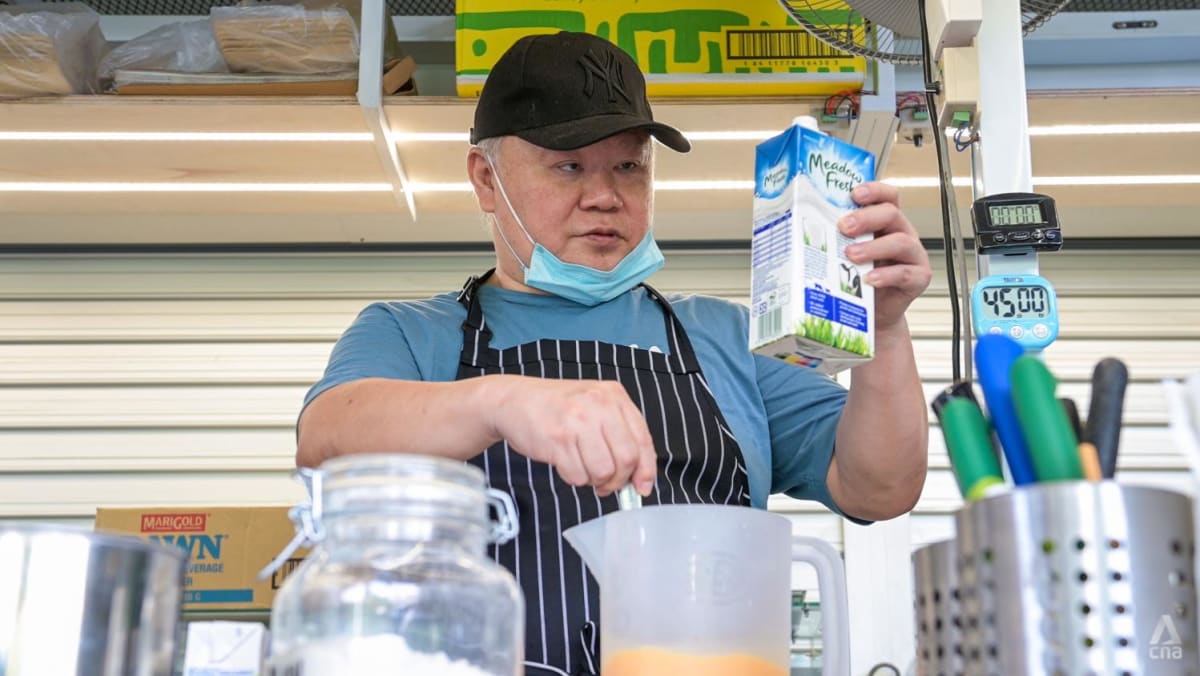SINGAPORE: At Kunyah Cafe, weighing scales can speak, light switches are paired with dimmers, and its chefs are more afraid of prejudice than sharp knives.
And the signature sandwiches — filled with crispy breaded chicken thigh, tempeh, otah or shrimp cake — were creations of two visually impaired chefs.
Alex Seow lost 70 per cent of his vision at age 50 owing to complications from a cataract surgery; Ernawati Fauzana Zakaria, 38, has had glaucoma since the age of 10 and cannot see objects in focus.
Seow, now 55, has been a chef for more than a decade, his career truncated after the surgery. Erna, as she likes to be addressed, gained her love of cooking from her mother, who made her learn from a young age so that she would grow to live independently.
These qualities were what inspired Aaron Yeoh, who is sighted, to set up the cafe with them — never mind that they would have to cook differently.
The journey towards those first two sandwiches has not been easy, and not necessarily because of the chefs’ disabilities. Differences have emerged, and Erna has left. Still, the folks at the cafe are determined to make a success of it.
RETHINKING THE KITCHEN
In 2018, together with Erna, Yeoh started free cooking classes for the visually impaired to find out what would help them be more confident in the kitchen. The pair were also looking for someone to join their business.
They tested out assistive devices, like weighing scales that read out the amount of ingredients added and induction cookers that read out the stovetop temperatures.
The tools did give the students more confidence, said Yeoh, but none were passionate enough to turn their culinary skills into a career. Then came Seow, who was referred to Yeoh by a friend.
Having lost most of his vision, Seow felt like a burden in the last kitchen where he worked.
“Sometimes I needed (my colleagues) to help (by) looking at the menu or the food. … After helping (me) for a long time, there was some friction,” he said. “I felt it was quite difficult and resigned from the job.”
When the call from Yeoh came, Seow was “honoured”, albeit worried about the problems his eyesight would bring. “But (Yeoh) told me we can gain experience from these difficulties,” said the designated head chef.
The chefs’ anxiety showed a little, however, when asked how they would know whether their food is cooked.
In the past, Seow could tell with one look. With things not as “obvious” now, he lets the food cook for longer just in case. Erna would poke the meat to check for doneness.
But with a business to run and safety to ensure, there is kitchen assistant Chan Lay Hoon, who is sighted, to double-check. Chan, 61, used to work in a flavouring company and volunteers her time for the cafe.
She also turns the knobs on the fryer and the toaster to the right temperatures, she said, and helps in cleaning the dirt off ingredients like onions, shallots and ginger more thoroughly as well as in chopping them.
Everyone was everywhere all at once. If Erna could have it her own way, she would have everyone walk only in a clockwise or anticlockwise direction, she said, her ire aroused.
“There are a lot of danger spots, especially where the deep (fat) fryers are. If you (don’t) co-ordinate and make your move properly, anything could happen, like food spills, or someone may get hurt.”
Then there were instances where it could be said that too many cooks spoil the broth.
The team could hardly agree on how long to toast the bread for their sandwiches, especially since they were using the toaster for the first time. Seow insisted that it should be toasted longer for crispness, while Chan felt it would be charred.
“What I see may not be what he sees,” said Chan. “It could be shade of five, but to him it could be shade of three or two. So we had to come to a compromise.”
And while Erna was slathering the chicken and tempeh sandwiches with rendang gravy, she got “frustrated” when Chan told her there was too much sauce while “someone else” complained that it was too little.
“Let me do my thing, you know,” said Erna. “The person wrapping (the sandwiches) is responsible for how much sauce they use.”
While Oh’s speech is slurred and her movements are not nimble, she can handle tasks such as breading and packing. She is also learning from Seow to stir-fry vegetables for the bento boxes.
Asked how she finds working with the team, Oh said: “What Aaron’s doing is very good because he believes in disabled people.”
On the opening day, the team was steady and organised.
Seow was in charge of deep-frying and reading out orders, which he did by bringing the chits right to his eyes. Chan assembled the sandwiches while Oh packed and passed the food to the customers. Even Yeoh’s mother had come to help assemble bento boxes.
Yeoh himself talked to customers and shared the team’s story. There is no shop sign, however, asking customers to be patient as the chefs have disabilities.
“To create a mindset shift, I think we need to do the reverse. We let (customers) experience the food first, then we let them experience the team,” said Yeoh. “That’ll create a deeper impression.
“Hopefully, they can inspire more change in the community.”


